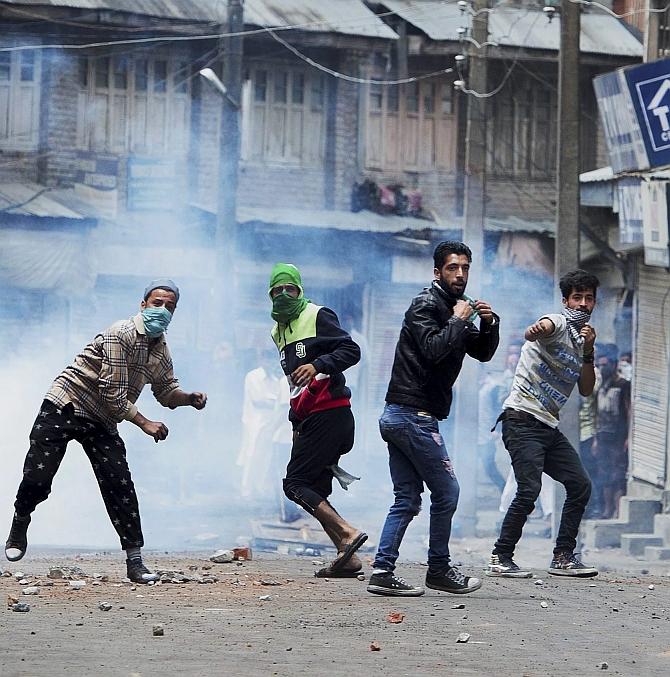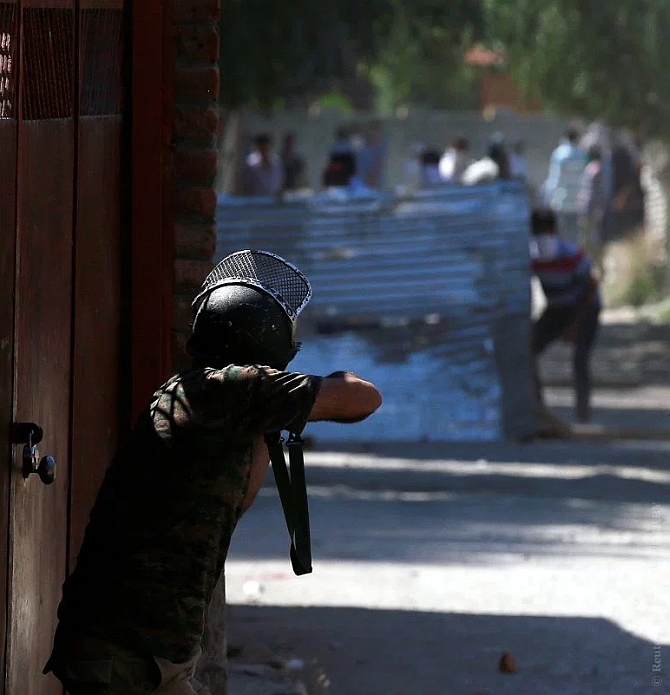 | « Back to article | Print this article |
'Burhan Wani’s killing served as a spark for the anti-establishment fire that has been raging in the minds of Kashmiris ever since the Centre stopped engaging them for their political future.'
'... before the upsurge the Hurriyat had begun to feel isolated and marginalised, many had begun to term them as irrelevant. But they are now back in the game.'
'The cardinal weaknesses shown in use of pellet shotguns are clearly due to lack of training on their use.'

Nearly two months since the killing of Hizbul Mujahideen militant Burhan Wani in an encounter with the security forces, the Kashmir Valley remains shrouded in grief, anger and frustration.
As dawn breaks everyday, mobs armed with sticks, stones and molotov cocktails emerge from homes to take on the collective might of a flailing administration for the cause of 'azadi'.
But beyond the bold headlines and blaring prime time news shows, not much has really emerged from the Ground Zero of protest.
To clear the air, Vipin Vijayan/Rediff.com reached out to Air Vice Marshal (retd) Kapil Kak, who has been part of the track II process which seeks to reach out to members of the civil society in the Valley to understand the ground reality and provide inputs to the government.
Air Vice Marshal Kak is a former deputy director of the Institute for Defence Studies and Analyses and the founding additional director of the Centre for Air Power Studies in New Delhi. In recent years, he has represented India in a number of Track II conferences on international security and strategic issues, and been part of many initiatives on the India-Pakistan peace process and conflict resolution in Jammu and Kashmir.
The highly-decorated officer says the onus for restoring normalcy in the Kashmir Valley lies with the Centre and the state government together reaching out to all the stakeholders.
Burhan Wani's killing seems to have touched a raw nerve with the Kashmiris. Help us make sense of the sudden spurt in anti-establishment sentiment. Or has it been that this sentiment has been simmering for a while now and simply boiled over upon the militant's killing?
The latter part of the question itself provides the answer. Burhan Wani’s killing served as a spark for the anti-establishment fire that has been raging in the minds of Kashmiris ever since the Centre stopped engaging them for their political future.
The last such effort was the interlocutors report of 2011 which has been gathering dust in North Block (which houses the PMO, home ministry, etc) ever since.
This was the unanimous opinion of a large body of civil society comprising University teachers, lawyers, traders, manufacturers and sundry professionals I interacted with during two visits to Kashmir in the last three weeks.
My second foray was as part of a 8-member delegation comprising a political leader, journalists, social activists, and a security analyst among others.
How did Burhan Wani turn into an inspirational figure for the Kashmiri?
Burhan Wani gave up studies to join militancy in 2011 when he was just 17. He soon gained a poster-boy image, and became a symbol of ‘new militancy’, in which educated, technology-savvy, social media-adept teenagers from relatively affluent families, who are ready to die, acquire iconic status.
Sometime last year, a photograph of 10 militants, including Burhan Wani, all in jungle fatigues and bearing AK 47s, went viral on the social media.
Professors at the Kashmir University told our delegation that militants spearheading the current upsurge are 12 to 16 years of age, fearless and ready to die.
And we were told elders have lost control over the young.
Worryingly enough, there is a growing cult of martyrdom.
As a journalist-friend rightly averred, "there is an ecstasy in confrontation that borders on a love affair with death."
There are reports that the writ of the government has stopped functioning in South Kashmir. Is there any truth in these claims? If so, in what manner?
In a situation of what I term 'curfewed neo-normalcy', continuing protests over 48 days, 50-60 people getting injured daily in stone-pelting and counter actions by police, there is obviously pressure on the writ of the government, more so in South Kashmir, the centre of gravity of current upsurge.
Notwithstanding the monumental challenge, the Mehbooba Mufti-led government, ably supported by the Centre, has not been found wanting in timely delivery of goods and services to public.
The security forces are fully in control of the situation; yet they are restrained enough to let the youth let go the anger steam.
Health services, hospitals, utilities, municipalities are on full throttle.
Despite attendance in offices being restricted to about 10 per cent, the top civil and police administration is performing its functions admirably.
Calls of Azadi have been heard across the Valley over the last 45 days. What's the premise of this demand?
In general, anger against the Narendra Modi-led central government and support for Azadi stretches all across the Valley.
There are small numbers who seek sovereign independence or merger with Pakistan, the latter demand having been consistently advocated by the hard line All Party Hurriyat Conference leader Ali Shah Geelani.
In the entire spectrum of civil society, our delegation interacted with over three days, there was unanimity that they would not wish to join Pakistan.
But they were equally vehement on their grievance that the special status accorded to J&K state under India's Constitution had been severely eroded ever since the arrest of Sheikh Abdullah in 1953.
One gathers the impression that genuine autonomy as an alternative to sovereign independence would be an option that would resonate among the majority of Kashmiris with suitable devolutionary checks and balances provided to the people of Jammu and Ladakh.
With violence continuing unabated and the toll rising by the day, where does Kashmir go from here? How do you see this situation being resolved?
The immediate priority should be restoration of a modicum of normalcy progressively improving the same so people can get onto routine workaday living.
The onus for this lies with the Centre and state government together reaching out to all the stakeholders.
Expression of remorse on excessive use of force and the consequences it had on young teenagers by way of deaths and serious injuries, immediate ban on use of pellet guns, promise of selective revocation of AFSPA from a few districts, opening of official and non-official dialogue channels with the separatists and others and announcement of CBMs that would serve as a balm for the wounds in the minds of Kashmiris could be measures that would help resolve he situation.

The government alleges that the separatists have been fuelling the protests in Kashmir. What's your take on this?
The protests were spontaneous. But once these reached a critical mass, not only the separatists but even Pakistan leveraged the opportunity that came their way.
The protestors do not fully adhere to the shut-down calendars announced by separatists. In fact, before the upsurge the Hurriyat had begun to feel isolated and marginalized, many had begun to term them as irrelevant.
But they are now back in the game. And a dialogue by the Centre with them has to be a way point on the forward pathway.
Kashmiri leaders allege that the use of pellet shot guns by security forces has been a catalyst to the protests. But the troops on the ground claim there's no other way to respond to the threat from large mobs that pelt stones. Opening fire could further antagonise the mob, they say. Negotiations aside, how should the security forces deal with the protestors on the ground?
One does not want to appear cynical. Even one death is one too many.
But as far higher casualties in conflicts elsewhere in the world suggest, 70 deaths in 48 days of mass upsurge are the result of restraint shown by both the stone pelters as also police forces.
Doubtless, in some situations, possibly due to panic, police and the Central Reserve Police Force did use excessive force. But the cardinal weaknesses shown in use of pellet guns are clearly due to lack of training on their use.
Because firing these at point blank ranges caused devastating injuries, including 200 cases of eye/retinal damage. Somewhere between 60-100 youth may be blinded in one or both eyes forever.
The home minister has promised alternatives to pellet shotguns, options which need to be explored on priority.
More robust crowd control and stone-pelting countermeasures training have to be imparted to the police and the CRPF deployed in the state. These are all a reflection of our non-professional and chalta hai approach.
There is a near-unanimous agreement in Kashmir that the media has not being reporting the entire truth on the ground. Kashmiris claim television channels have kept peddling lies as news. So what is the entire truth? What is the message that the Kashmiri on the streets of Srinagar wants to convey to the rest of the nation?
The Kashmiris, through our delegation, collectively conveyed a precise and unambiguous message, pointedly referring to three television channels -- "They lie through their teeth, they misrepresent us, call us terrorists."
One television anchor, whose name can easily be guessed, is a unanimous object of hate throughout the valley.
Would I be wrong when I say that agencies in Pakistan have no role to play in fuelling protests in the Valley? Many believe that it is in Pakistan's interest to keep the Valley in a state of permanent unrest.
You are not wrong. Pakistan had no role in fuelling the mass upsurge. After Wani's killing in South Kashmir, the wave of sympathy and outrage was all pervasive and immediately spread to the entire Valley.
The fact that nearly 2 lakh mourners held about 40 ceremonies in his memory over a 12 hour period after his body was handed over to the family is indicative of his cult following.
Pakistan was clearly not involved in all this.
It is also true that the so-called deep state in Pakistan has a huge stake in keeping the Kashmir pot on the boil to distract Pakistani people from the calamitous internal problems.
Although cases of successful cross LoC infiltration are on the rise (there have been 85 cases in six months of 2016), the level of casualties because of cross border terrorism have been in a steep continuous decline from 2002 onwards.
Perhaps the time has come to initiate a serious dialogue not the least because such a move would help impart greater acceleration to the New Delhi-Srinagar dialogue which must commence first.
What should the Narendra Modi government do to assuage the people of Kashmir?
The prime minister's promises at the all-party meeting -- after a 45-day silence which deeply hurt the civil society cross-section we met -- and Rajnath Singh's second visit to Kashmir presage encouraging political initiatives in the short term for the agitators to respond appropriately.
In the medium term, initiation of a creative and innovative peace process involving multi-track dialogue with multiple stake-holders, as also a dialogue with Pakistan could lead to a political resolution acceptable to India, Pakistan and the people of Jammu and Kashmir.
My own view is that greater devolution of political power with cross-LoC trade and people-to-people linkages envisaged in the so-termed 4-point mutually agreed between Musharraf-Vajpayee and Musharraf-Manmohan Singh during 2003-2007 -- the so-called golden period in India-Pakistan and Centre-Srinagar/Jammu relations -- appropriately repackaged, is a viable way forward.
But a sincere 'uninterruptable and uninterrupted' dialogue process constitutes a critical prerequisite.
It would be a long haul, but Prime Minister Narendra Modi has to make the effort sincerely and resolutely.
REDIFF RECOMMENDS